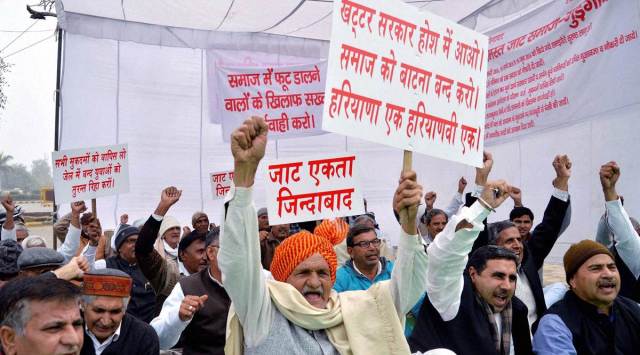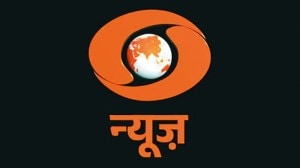- India
- International
BJP’s target: Reservation deconstructed
The party seems to be working on a strategy to divide the OBC agrarian castes.
 Jat community members stage a protest demanding reservation in OBC quota in Haryana (File/PTI)
Jat community members stage a protest demanding reservation in OBC quota in Haryana (File/PTI)After CAA 2020 and the farm bills, what will be the next target of the BJP and the Sangh Parivar? Does the Centre’s delay in reconstituting the Parliamentary Committee on Welfare of Other Backward Classes (OBCs) offer any clues? Do the bids to include salary as a factor to calculate the creamy layer and move for sub-categorisation of OBCs, in the context of reservations, foretell anything?
A large section of the agrarian community in the Hindi heartland belongs to OBC communities. The BJP believes that the bid to dilute OBC reservations could pit various OBC communities against each other in the near future. The party is aiming to woo a section of the OBCs and silence others on the pretext of “targeted reservation” for the “most marginalised”. Its aim seems to be that of weakening the farmers’ protest.
The decision to keep the reconstitution of the Committee on Welfare of OBCs in abeyance is detrimental to the aspirations of the OBCs, especially the youth. The Committee’s mandate is to “examine the measures taken by the Union Government to secure the representation of the Backward Classes”. The prevarication creates suspicion that the Sangh Parivar’s anti-reservation mongering will soon be espoused by the Centre to strengthen its political agenda.
The rules regarding the constitution of Parliamentary Committee on OBCs specify that the “members of the Committee shall hold the office for one year from the date of the first meeting, which shall be reconstituted thereafter for one year at a time”. Given that eight other Committees were reconstituted by the Centre in September, the decision to forego the reconstitution of the Committee on OBCs is remarkable. Let’s not forget the strong stance by the last Committee on OBCs against diluting the OBC reservations.
In its report last year, the committee on OBCs had noted that despite four revisions of the income criteria since 1997, the 27 per cent vacancies reserved for OBCs are not being filled up. As per data from the report, the Central government’s elite Group A category has only 13 per cent OBCs. Various estimates show, among the 32.58 lakh government employees, which includes Group A, B, C, the number of those from OBCs are 7 lakh or less than 22 per cent — as against the 27 per cent stipulated quota. The maximum number of OBCs (6.4 lakh or 22.65 per cent) are employed in Group C, which comprises mainly the safai karamcharis or the sanitation department staff. This too is well short of the stipulation.

In another report in July 2020, the Committee on OBCs recommended that an individual’s salary should not be included while calculating the annual household income that decides eligibility of family members for reservation benefits. The Committee also recommended increasing the annual income ceiling for creamy layer category of the OBCs from the current Rs 8 lakh to Rs 15 lakh. Currently, OBCs, barring the creamy layer, whose annual income is less than Rs 8 lakh are entitled to 27 per cent reservation in central government jobs and admission to educational institutions. The Committee has put on record that any effort to include salary in income calculations “leads to the inference and also apprehension that when stringent conditions are imposed for determining the creamy layer, the directive of the government to fill up 27 per cent of the vacancies by OBCs may not be achieved”.
As per a 1993 Union government document, the concept of creamy layer was introduced to exclude children of those who are in constitutional posts (such as the President of India), elite officers in government or military service, elite private professions (such as doctors), major property owners and people with high income, from the reservations, subject to realistic considerations. Hence, using the concept of creamy layer to topple reservations is ridiculous.
Surprisingly, despite the strong stance of the Parliamentary Committee on Other Backward Classes, led by an MP from ruling BJP, the Social Justice Ministry, instead of considering the recommendations of the report of the Committee, constituted an “Expert Committee” led by a retired bureaucrat to look into the reservations for OBCs! On such an important matter affecting the OBCs, the Social Justice Ministry did not include even a single OBC member in the Expert Committee
There are also other employment challenges for OBC candidates given that many of the PSUs are being sold off to private players. Post privatisation, the current job reservations for OBCs would also be a thing of the past.
The Committee had strong criticisms against the Centre for not having a provision for reservation of OBCs in admission to Kendriya Vidyalayas/Navodaya Vidyalayas even when the same is being provided to SC/ST students. The Committee had also found that the KVS and NVS have not amended their admission policy by incorporating OBC reservations in the last 13 years after the Central Educational Institution (Reservations in Admissions) Act, 2006 came into force.
The last Committee on OBCs strongly recommended that 27 per cent reservation in admission to Socially and Educationally Backward Classes of citizens in all private educational institutions, whether aided or unaided by the State as well as affiliated to the CBSE and other boards, other than the minority educational institutions referred to in clause (1) of Article 30 should be provided.
Recently the Centre gave its ninth extension — until January 31, 2021 — to the Justice G Rohini Commission, set up in October 2017 to “examine the issue of sub-categorisation” of OBCs in the central list to benefit the marginalised sections of the Backward Castes “who have not been able to get any major benefit” of reservation in jobs and education. When the Commission was set up in October 2017, it was to submit its report in 12 weeks — by January 2, 2018. Given the fact that the Assembly election in Bihar is to take place, the latest among the extensions given to the Committee is observed as a measure to keep the people and citizens aloof from the well-engineered agenda of BJP to topple the current state of OBC reservations.
At this juncture, it would also be interesting to study the recommendations of the Justice (retd) Raghavendra Kumar panel appointed by the Uttar Pradesh government in 2018 to divide the 27 per cent OBC bloc into three sections — Pichhra Varg (Backward Class) at 7 per cent, Ati Pichhra (More Backward) at 11 per cent, and Atyant Pichhra (Most Backward) at 9 per cent. Such categorisation could be used to cut down the reservation for OBCs in phases in future.
If the BJP was so keen on empowering the socially and economically marginalised sections of the population including the OBCs, it would have considered the reconstitution of the Parliamentary Committee on Backward Classes with immediate effect. Further, the party wouldn’t have attempted to dilute the current OBC employment reservation policy including the proposal of the Centre to include salary as a factor to calculate the creamy layer. It would have also considered legislation to ensure reservation to OBCs, SC and ST communities in the private sector.
Hence, the “targeted OBC reservation” rhetoric of BJP has several political dimensions.
The writer is a CPM Rajya Sabha MP and member, Committee on Welfare of Other Backward Classes
EXPRESS OPINION
More Explained
Apr 20: Latest News
- 01
- 02
- 03
- 04
- 05









































